Inside: Explore the fascinating world of lichens with our collection of beautiful prints from Johan Peter Westring’s 1805 masterpiece. Discover the art and science behind lichen dyes with detailed drawings and colour charts, perfect for artists, historians, and DIY enthusiasts.
When everyday life gets a bit too much for me, I take a few minutes to try and escape to my fantasy happy place, a Norwegian cabin (hytte) located in one of the stunning fjords.
Here I live a simple life crafting, growing and preserving my own fruit and veg. So when I came across these extraordinary Scandinavian Lichen drawings and accompanying dye colour charts, I added naturally dyeing fabrics to my list of wannabe cabin life activities.

What is Lichen?
A lichen is not a single organism but a combination of two, fungi and algae or cyanobacteria. They co-exist in a symbiotic relationship, the fungus provides protection and the algae provide chlorophyll so that the lichen can photosynthesize to obtain nutrients for growth.
Lichens are beautiful organisms that surround us everywhere we go. They come in many colours, sizes and shapes. Some may appear plant-like, but they aren’t plants. Others look like powders or thick paint clinging to various surfaces.
More Fun & Interesting Facts About Lichen
- There are over 17,000 species of lichen.
- Lichen can grow on stable surfaces, from rocks, trees, leaves and even artificial structures.
- They survive at any altitude and survive extreme environments from deserts, rainforests and even the arctic tundra.
- Lichens can even survive in space. A European Space Agency mission exposed lichen to the space environment for 15 days with no effect on the health of the organism.
- Lichen covers about 7% of the surface of the world.
- Lichens are considered one of the oldest living organisms and can be used to date rocks, known as Lichenometry.
- The world’s oldest living organism, dated at 8,600 years, is an Arctic species of Lichen called “map lichen”.
- Lichens are pioneer species and are the first living things to grow on freshly exposed rock after landslides.
- The manufacture of the pH indicator litmus involves a lichen dye.
- Many traditional textiles such as Harris Tweed get their colour from Lichens.
- Scientists since 1859 have used the health of lichens as an environmental indicator. They absorb everything around them from air, water and pollutants.
- Lichen changes colour depending on whether it’s wet or dry. Drawings for identification purposes are the colour of the organism when dry.
- Lichen is an important food source for some species, such as caribou and reindeer, where it makes up two-thirds of their diet.
- For thousands of years, some species have been important dyes for cotton, silk and wool. Colour pigments extracted from the organism include vibrant yellows, deep reds, purples and earthy hues.
The Lichen Drawings and Colour Dye Charts
The following beautiful prints include lichen drawings and a colour chart of the pigments obtained from that particular species.
All the prints are from “The Color History of Swedish Lichens, or, The Way of Using Them for Dyeing and Other Household Purposes.” By Westring, Johan Peter, 1805.
Click on the title above the lichen drawing you want to download. A higher resolution lichen illustration will open in another window in your browser. Click on that image to save or print it.
Plates 1- 7 Lichen Drawings

More commonly known as the salted shield lichen. It mainly grows on rock but is found on bark or wood. The lichen is called “crotal” in Scotland and is used to make dyes with deep red-brown and rusty-orange colours for traditional cloths such as Harris tweed.


Plate 4: lichen Pseudo-corallinus
From looking at the colour chart this lichen species is very good for obtaining orangy pigments.

A very detailed drawing of Lichen Candelaria shows the eight pigments that can be extracted from pale yellow to black.
Wresting describes this as a common lichen that grows everywhere, especially in old hedgerows, where it’s collected in large quantities. It also grows on old wooden house walls, on the bark of trees, and also sometimes on large loose stones.
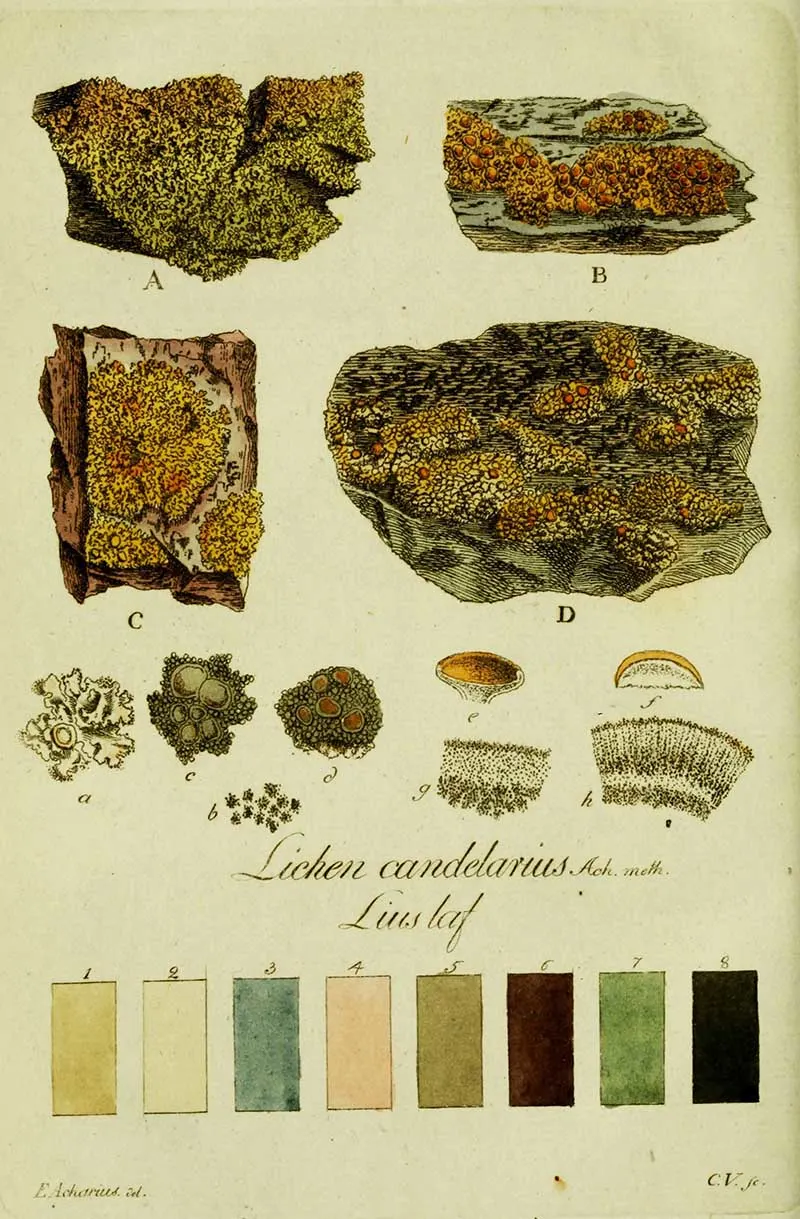
“It grows on mountainsides and large loose stones in large patches, often from one to two cubits in diameter. Its crust is thick, often 1 inch, and is loose; has a bumpy and wrinkled surface of a greenish-yellow colour, striped in small squares; with lots of reddish-brown seed-saving bowls, which are usually flat.“
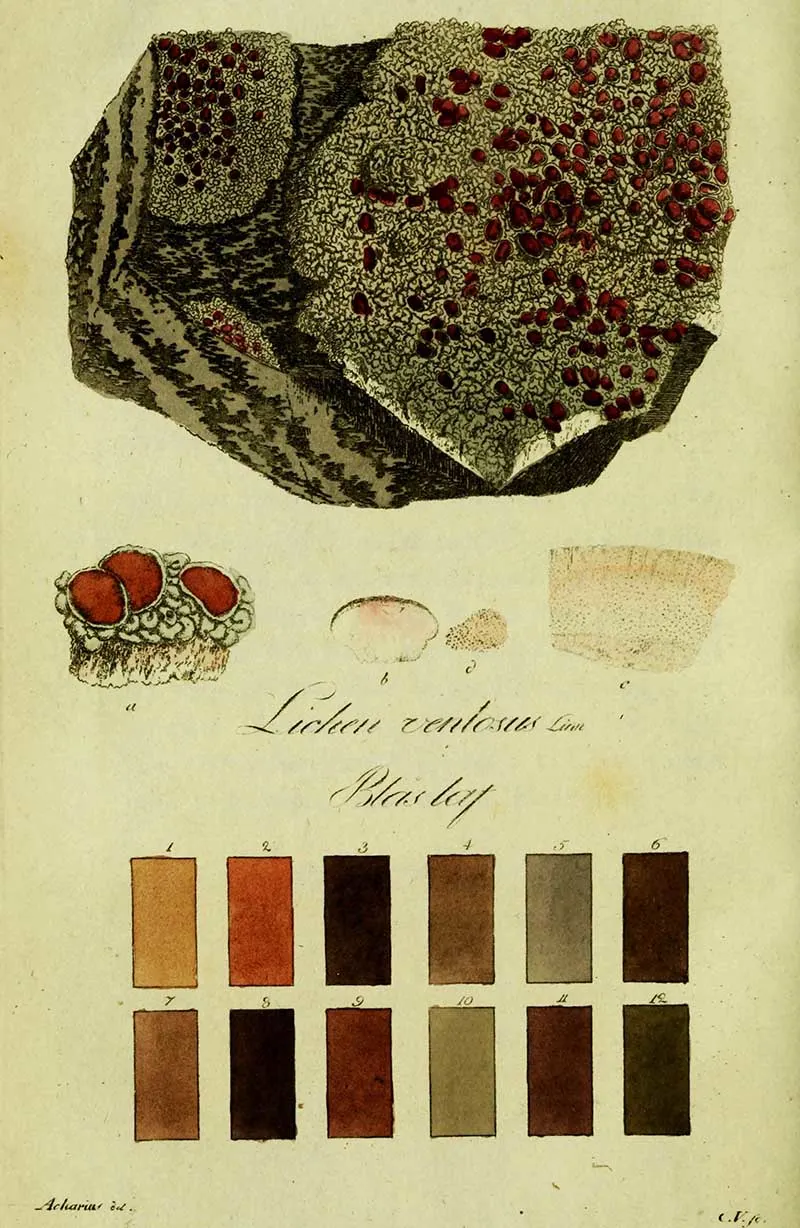
The lichen is widely distributed, having been recorded in Asia, Africa, Europe, and North and South America.

Plates 8 -14 Lichen Drawings
This is a species of beard lichen.

The lichen in this drawing is also known as Saffron coloured lichen.

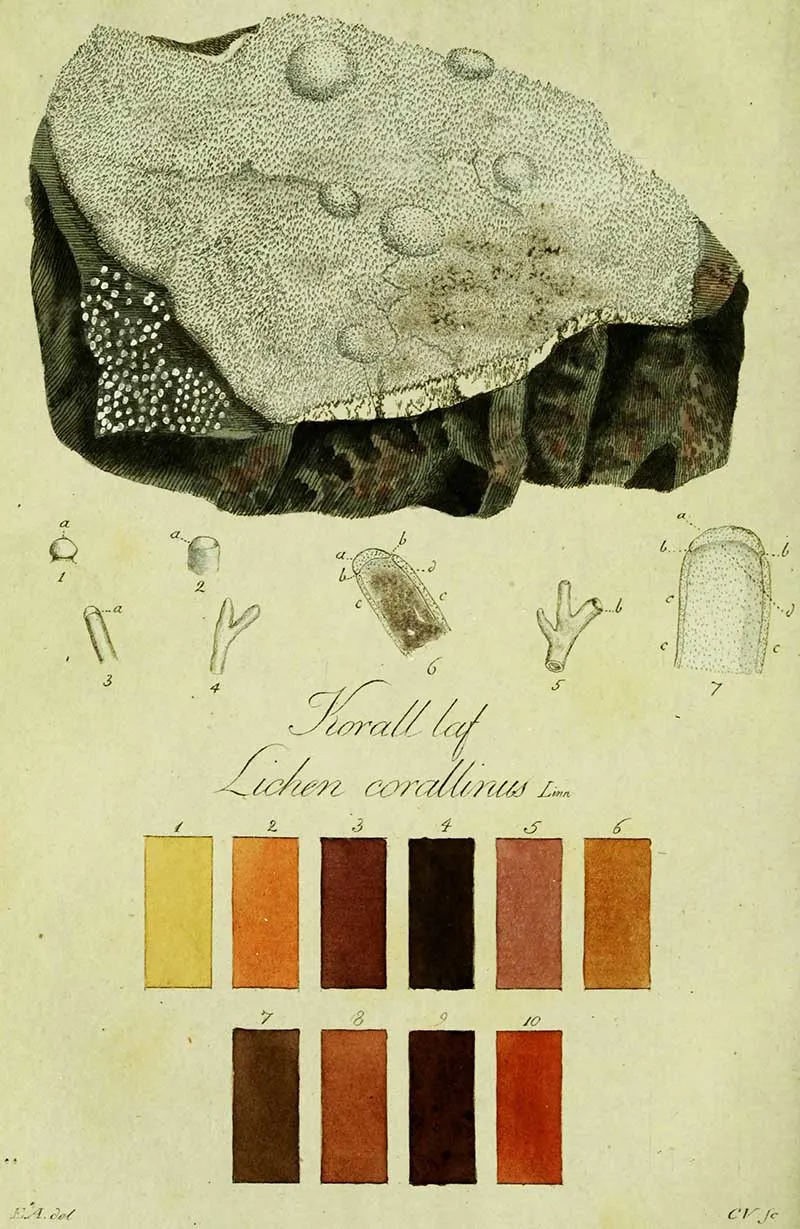
More commonly known as oakmoss, it’s common throughout the Northern hemisphere and grows on oak trees, hence its name. It also grows on some species of conifer trees. The lichen has a distinct odour and is harvested for the perfume industry, but it can irritate the skin.




Plates 15-21 Lichen

Commonly known as Iceland moss as it grows abundantly on the lava slopes in Iceland and the mountainous regions of other northern countries. It is edible and sometimes used as a food thickener. Iceland moss is an alternative medicine for chest problems.

Also known as pebbled cup lichen.
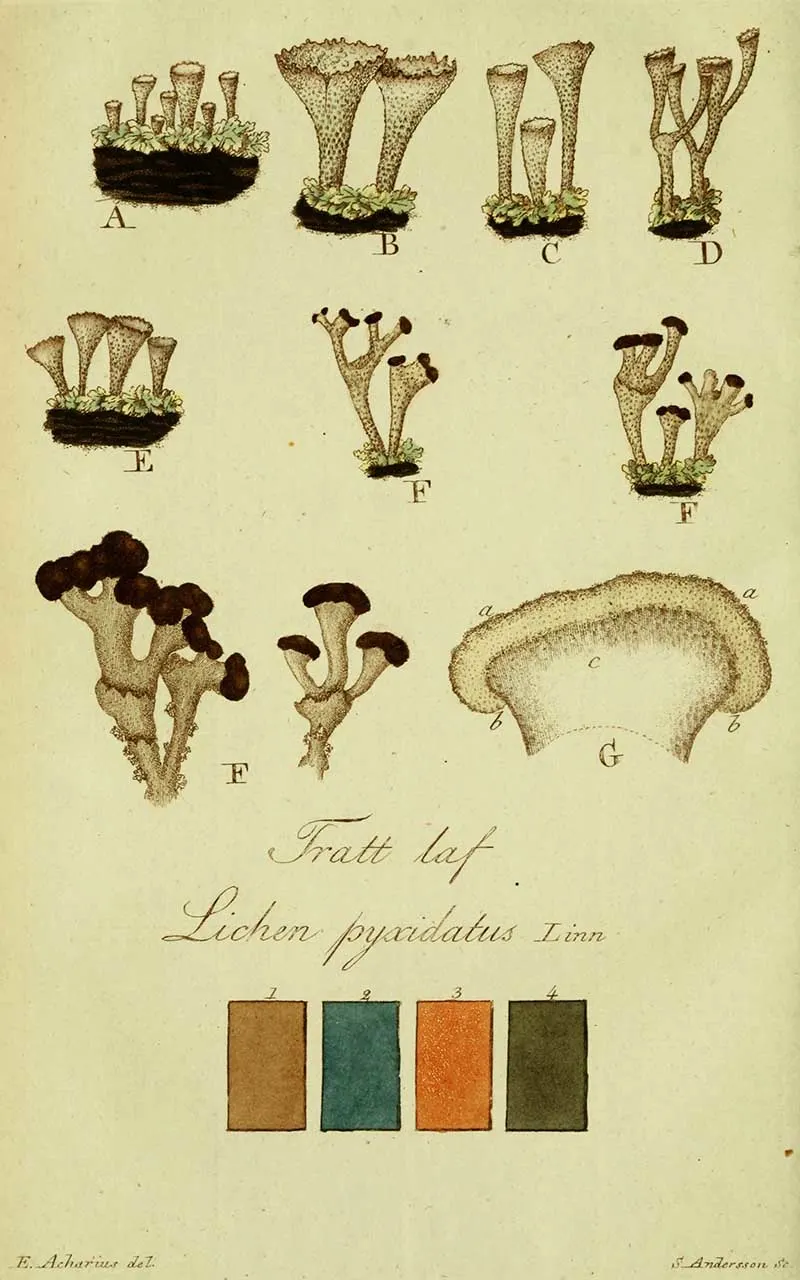
Print 18: Lichen cinereus

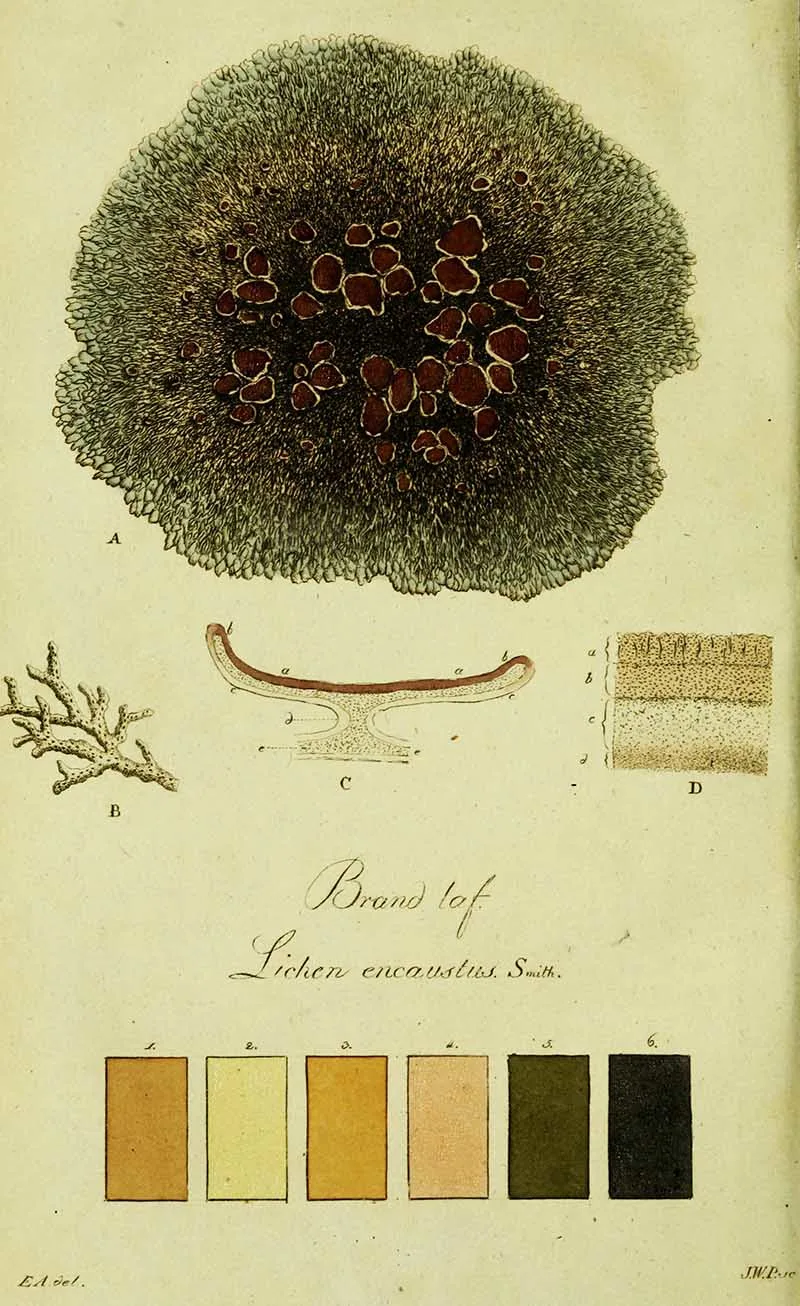
Lung lichen usually grows on the bark of broad-leaved trees such as oak, beech and maple. But will also grow on rocks and has been grown in the laboratory on artificial surfaces. It has been used in herbal medicine.
Lung Moss has also been used to produce an orange dye for wool, in the tanning of leather, in the manufacture of perfumes and as an ingredient in brewing.
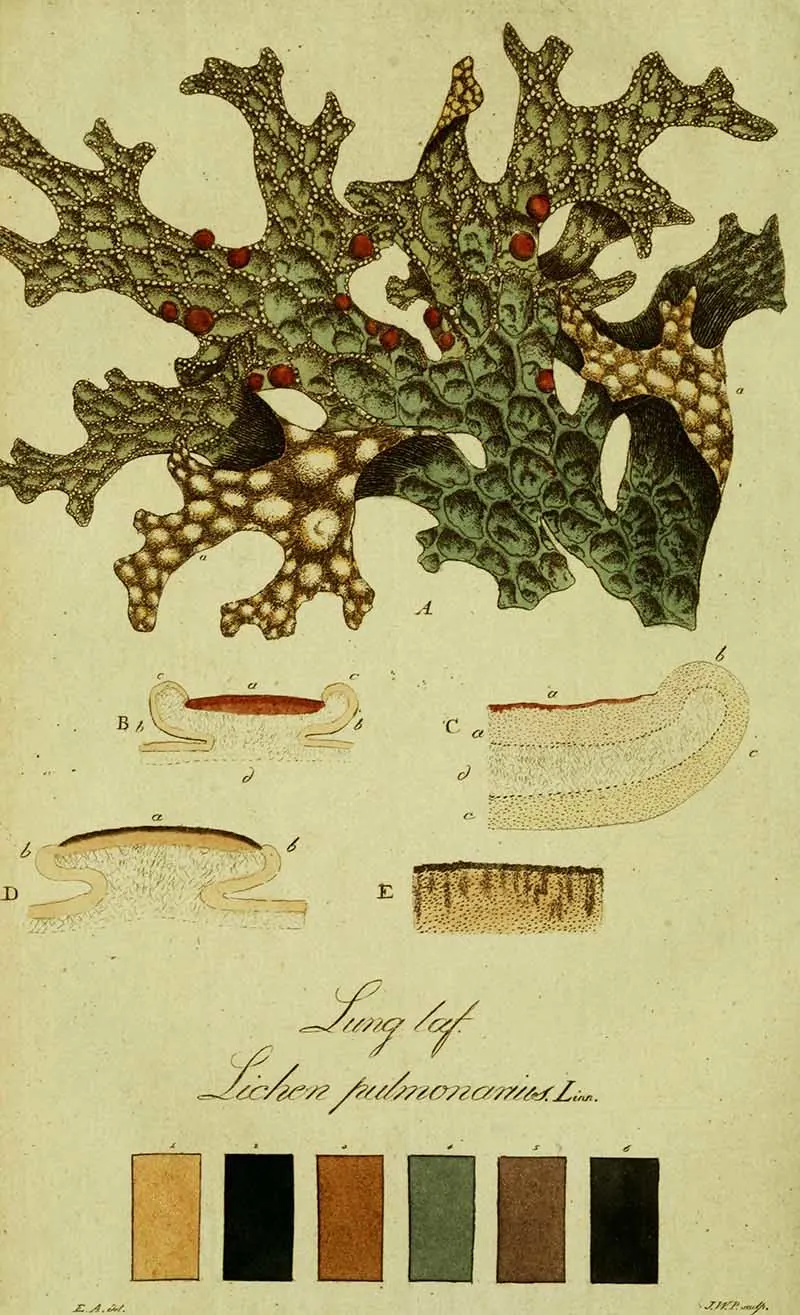
Commonly known as blood stain lichen.

Plates 22- 24 Lichen Illustrations
Commonly known as peppered rock tripe, it grows on exposed boulders and rocky outcrops.

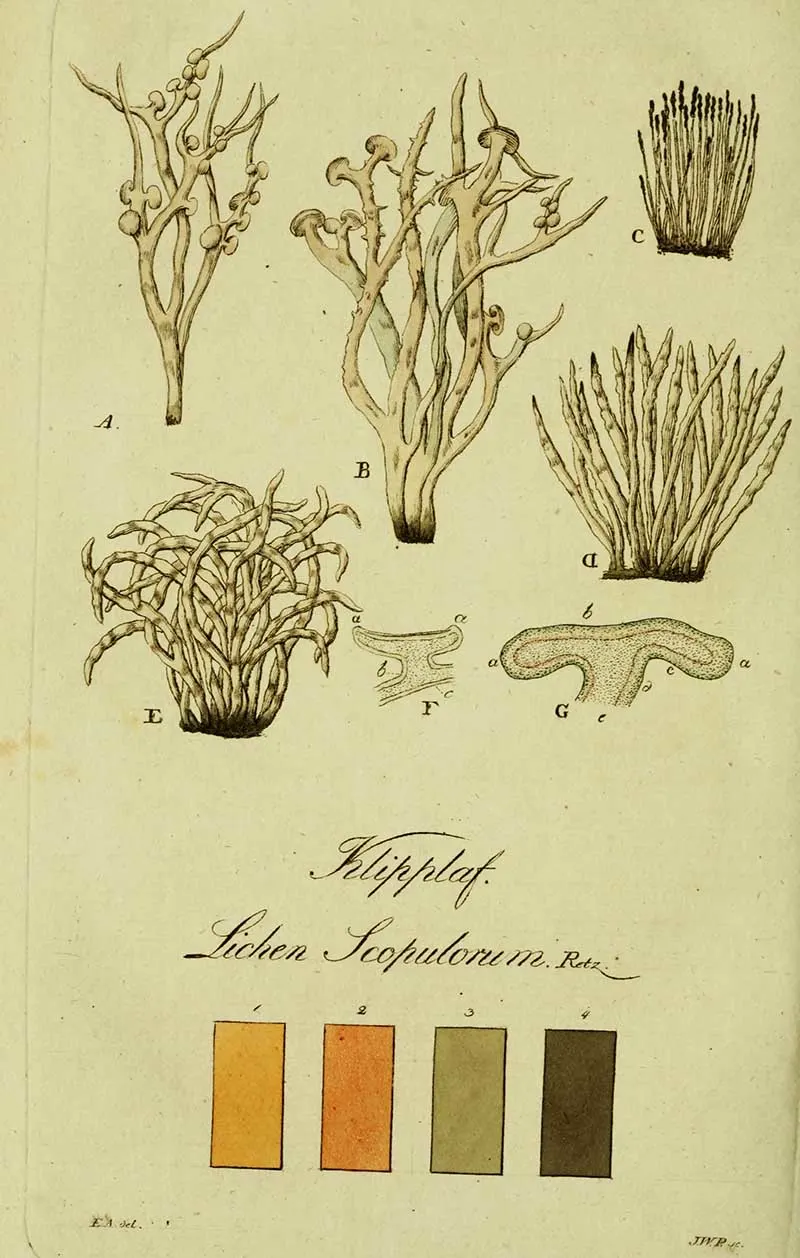
This lichen is commonly known as the peppered rock-shield.

Conclusion and Other Posts
Since discovering these prints, I’ve been scouring the world around me for lichen. It’s everywhere once you start looking for it. I can’t wait to try out some natural dyeing using plants and lichen.
Don’t forget to check out many more of my natural history posts. There is an excellent poster of moss types in this collection of vintage nature posters by Oliver Goldsmith.
If you like paint swatches and pattern templates, there are plenty of these in the Art & Design section of the blog, such as the vintage colour wheel charts and the nature form patterns of Haeckel.
Do you fancy sketching your lichen? you might want to check out this how-to-draw mushrooms and fungi tutorial for inspiration.
If you fancy, you can Buy Me A Coffee Here.

Helena
Wednesday 17th of April 2024
Thanks for sharing these stunning images so freely! Do you have any kind of key that tells what was used to alter/extract the pigments to get the different hues?
claire
Thursday 18th of April 2024
I’m glad you like the pictures. Unfortunately I don’t have a key as the images are from a 18th Century Swedish book.
lacham
Saturday 18th of February 2023
These are great. I search for historic colours and had not seen these yet. Thank you!
claire
Sunday 19th of February 2023
Thank you, glad you find them useful.
Gwen McMartin
Friday 2nd of September 2022
Fantastic images!! Thank you so much!
claire
Monday 5th of September 2022
Thank you, you're welcome 😊
Junie
Friday 26th of August 2022
Absolutely stunning plates. I remember being blown away by the varying colours of the lichens on the rocks when I was in the Antarctic Peninsular. Even more amazed at their age - so would never step on them. Thanks for sharing! (p.s. Love the extra research you add to your posts.)
claire
Friday 26th of August 2022
Wow, that must have been an amazing trip. I've never managed to travel that far south. Thank you.
Anne
Thursday 25th of August 2022
Thank you! I really enjoyed this information. My house in the woods is light green because I was inspired by the lichen on the trees around the house. I make a medicinal tincture out of Old Man's Beard lichen. 50 years ago I lived in Alaska, and remember the beautiful tundra with it's deep interesting mix of mosses and lichen, and still enjoy the beautiful lichen on rocks along hiking trails. My interest was raised as I read the information about purple dye as I recalled the information about Lydia- who sold purple cloth in Acts 16:14. Thank you for sharing the information and beautiful art.
claire
Friday 26th of August 2022
Your house in the woods sounds lovely and living in Alaska must of been an amazing experience. I make a tincture out of elderberries but never thought of making one out of lichen.